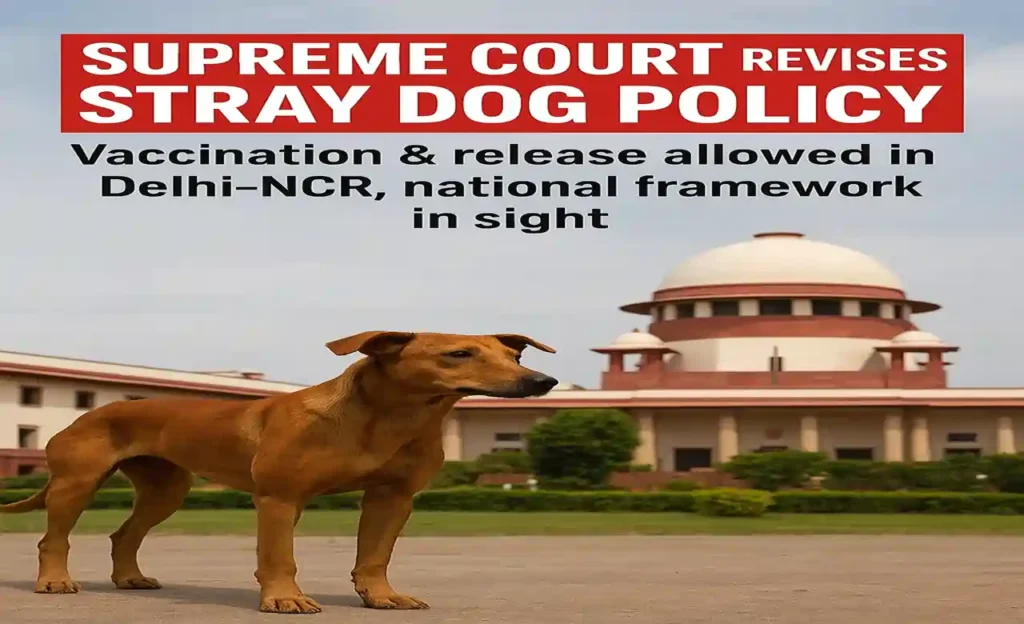New Delhi: In a landmark decision addressing India’s escalating stray dog crisis, the Supreme Court (SC) on Friday, August 22, 2025, modified its earlier directive, allowing stray dogs in Delhi-National Capital Region (NCR) to be returned to their original locations after sterilization, deworming, and vaccination. The ruling, delivered by a three-judge bench led by Justice Vikram Nath, alongside Justices Sandeep Mehta and N.V. Anjaria, reverses the court’s August 11 order mandating permanent confinement of strays in shelters. The decision also bans public feeding of stray dogs, mandates dedicated feeding zones, and expands the case to formulate a national policy by including all States and Union Territories.
This ruling comes amid growing concerns over public safety, with India accounting for 36% of global rabies deaths and dog bites causing 99% of human rabies cases, according to the World Health Organization. The stray dog population, estimated at 1.5 crore nationwide per the 2019 livestock census, and between 8 to 10 lakh in Delhi alone, has fueled debates on balancing animal welfare with human safety.

From Confinement to Compassionate Release
On August 11, 2025, a two-judge bench of Justices Pardiwala and Mahadevan had ordered civic authorities in Delhi-NCR to round up all stray dogs within eight weeks and house them in shelters with a capacity for at least 5,000 dogs, prohibiting their release. The directive sparked protests, including a demonstration at Connaught Place on August 16, 2025, captured by photographer Shashi Shekhar Kashyap for The Hindu. Animal welfare groups argued that mass confinement violated the Animal Birth Control Rules, 2023, and could lead to overcrowding and culling.
Responding to interim pleas challenging the order, the Supreme Court revisited the issue. Solicitor General Tushar Mehta, representing the Union Government, highlighted the public health crisis, noting that most rabies-related fatalities involve children. Delhi recorded 25,201 dog-bite cases in 2024, underscoring the urgency of the situation. The earlier order emphasized proper care for shelter dogs, ensuring they were not mistreated, with vulnerable animals housed separately and provided veterinary care.
The modified ruling stays the prohibition on releasing strays. “The dogs, once dewormed and vaccinated, shall be returned to the same area,” Justice Nath declared, clarifying that dogs with rabies, suspected rabies, or aggressive behavior must be sterilized and immunized but kept in separate shelters. The court termed its earlier directive “too harsh” and aligned the new order with the 2023 Animal Birth Control Rules.
Key Directives: Feeding Zones, Adoption, and Legal Accountability
The Supreme Court introduced several measures to address the stray dog menace while ensuring humane treatment:
- Prohibition on Public Feeding: Feeding stray dogs on streets or public spaces is now illegal. The court noted that indiscriminate feeding has led to incidents, including attacks. Violators face legal action under the relevant framework.
- Dedicated Feeding Spaces: Municipal authorities, including the Municipal Corporation of Delhi (MCD), must create designated feeding areas in each municipal ward. Notice boards will indicate these zones, and the MCD will establish a helpline to report violations.
- Relocation After Treatment: Stray dogs, except those with rabies or aggressive tendencies, must be sterilized, dewormed, vaccinated, and returned to their original locations.
- Adoption Encouraged: Animal lovers can apply to municipal bodies to adopt stray dogs, preventing their return to the streets.
- Financial Contributions: Individuals and NGOs approaching the court must deposit ₹25,000 and ₹2 lakh, respectively, within seven days to fund infrastructure for stray dogs. Failure to comply will bar them from further participation in the case.
The court reiterated that no individual or organization should obstruct these measures, reinforcing compliance with paragraphs 12, 12.1, and 12.2 of the original order. The matter is scheduled for a follow-up hearing in eight weeks.
Nationwide Policy and Infrastructure Development
Recognizing the stray dog issue as a national concern, the Supreme Court expanded the case’s scope, impleading all States and Union Territories, along with their Chief Secretaries, to consolidate related High Court cases. “We are suggesting some modifications to the prior suo motu order,” Justice Nath stated, emphasizing the need for a uniform national policy to address the crisis comprehensively.
The MCD is already taking steps to comply. On Thursday, August 21, 2025, a senior official revealed plans to identify land in Dwarka, Bela Road, and Ghazipur to house approximately 6,000 stray dogs in phase two of the shelter drive. A 2.5-acre plot in Dwarka, capable of accommodating 1,500 dogs, is a key site. “Though the work has not started yet, there is an unused building on the plot that can be converted into a shelter home. We aim to complete the work within the six to eight weeks given by the court,” the official said.
Reactions: A Blend of Relief and Calls for Clarity
The ruling has been widely welcomed. Animal rights activist and BJP leader Maneka Gandhi praised it as a “scientific judgment,” noting that relocation and fear are primary reasons for dog bites. She highlighted the government’s allocation of ₹2,500 crore for the program, as announced in Parliament, marking a significant commitment after 25 years. However, she called for a clear definition of “aggressive dogs” to prevent misuse.
At Jantar Mantar, animal lovers celebrated the verdict, hugging and raising slogans. An activist expressed “immense relief,” stating, “Today’s decision gives us hope that kindness and science will go hand in hand.” Alokparna Sengupta, director of Humane World for Animals India, described the ruling as “balanced, structured, and compassionate” but urged for scientific criteria to identify aggressive dogs to avoid arbitrary enforcement.
Political leaders also lauded the decision. Congress leader Rahul Gandhi, the Leader of Opposition in the Lok Sabha, called it a “progressive step” blending compassion and scientific reasoning. Delhi Mayor Raja Iqbal Singh pledged full implementation, stating, “The dog lovers and the NGOs also wanted the dogs to be sterilised and left. The corporation already did the same. Ferocious and aggressive dogs should be treated and kept.”
BJP leader Vijay Goel echoed this sentiment: “They have said that any dog suffering from rabies or involved in biting incidents will be caught on complaint and will not be released. This is a good step.”
The Broader Context: Public Health and Animal Welfare
India’s stray dog crisis is a public health emergency, with the country accounting for 36% of global rabies deaths. The 1.5 crore stray dog population, coupled with rising attacks, has heightened concerns. Articles like “Delhi’s stray dog crisis demands a One Health response” argue that mass removals are short-sighted, advocating for targeted vaccination, sterilization, public education, and waste management as cost-effective solutions. Another piece, “Shelter or vaccinate: Before deciding, India must count its stray dogs accurately,” emphasizes the need for precise population data.
Internationally, the ruling gained attention. BBC News reported that the Supreme Court’s decision followed protests by animal welfare groups against the earlier confinement order. The court’s shift to vaccination and release for non-aggressive dogs aligns with global calls for humane solutions.
What’s Next for India’s Stray Dogs?
The Supreme Court’s modified directive marks a pivotal moment in addressing India’s stray dog crisis. By balancing public safety with animal welfare, the ruling sets the stage for a national policy that could transform how the country manages its stray dog population. The emphasis on vaccination, sterilization, and designated feeding zones, coupled with adoption opportunities, offers a humane and practical approach.
As the MCD prepares to implement infrastructure plans and the court prepares to revisit the issue in eight weeks, stakeholders—from animal lovers to civic authorities—await the formulation of a comprehensive national framework. For now, the decision has brought relief to many, with hopes that science and compassion will continue to guide India’s response to this complex challenge.
FAQs
1. What changes did the Supreme Court make to its stray dog policy on August 22, 2025?
The Supreme Court modified its August 11, 2025, order, allowing stray dogs in Delhi-NCR to be returned to their original locations after sterilization, deworming, and vaccination, except for dogs with rabies, suspected rabies, or aggressive behavior, which must be kept in separate shelters. The court banned public feeding, mandated designated feeding zones, and expanded the case to formulate a national policy.
2. Why was the earlier Supreme Court order revised?
The initial order to confine all stray dogs in shelters without release sparked protests from animal welfare groups, who argued it violated the Animal Birth Control Rules, 2023, and could lead to overcrowding and culling. The court termed the earlier directive “too harsh” and revised it to balance public safety and animal welfare.
3. What are the new rules for feeding stray dogs in Delhi-NCR?
Public feeding of stray dogs is now illegal, with violators facing legal action. The Municipal Corporation of Delhi (MCD) must create designated feeding areas in each municipal ward, marked by notice boards. A helpline will be established to report violations.
4. How can animal lovers adopt stray dogs under the new ruling?
Animal lovers can apply to municipal bodies, such as the MCD, to adopt stray dogs. Adopted dogs will not be returned to the streets, providing a humane alternative to manage the stray dog population.
5. What steps are being taken for a national stray dog policy?
The Supreme Court expanded the case to include all States and Union Territories, impleading their Chief Secretaries to consolidate related High Court cases. This aims to create a uniform national policy to address the stray dog crisis, with a follow-up hearing scheduled in eight weeks.

